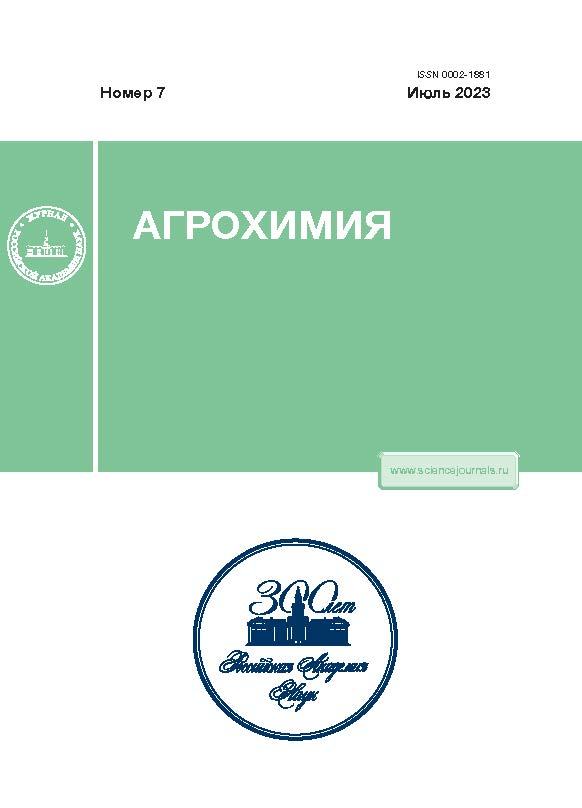Transformation of the Botanical Composition of the Herbage with the Use of Mineral Fertilizers and Sowing Seeds on the Developed Peat Bog
- Authors: Anisimova T.Y.1
-
Affiliations:
- All-Russian Research Institute of Organic Fertilizers and Peat – branch of the Upper Volga FASC
- Issue: No 7 (2023)
- Pages: 19-26
- Section: Experimental Articles. Fertilizers
- URL: https://kazanmedjournal.ru/0002-1881/article/view/647060
- DOI: https://doi.org/10.31857/S0002188123070037
- EDN: https://elibrary.ru/OEXABQ
- ID: 647060
Cite item
Abstract
The results of a 5-year study of changes in the botanical composition of seeded and natural herbage, soil properties depending on the applied agricultural techniques, which included direct sowing of grasses into the turf of the developed peat bog and the use of mineral fertilizers, are presented. The introduction of mineral fertilizers contributed to the enrichment of the soil with available nutrients, which made it possible to increase the productivity of herbs in combination with sowing by 2.0–4.7 times, to improve their quality by optimizing the botanical composition of the herbage. It was found that the use of mineral fertilizers in doses of N60P60K90 and N60P90K120 in variants with natural and cultural phytocenoses provided an increase in the proportion of valuable legumes and cereals, reducing the proportion of various grasses from 53 to 25–34%.
About the authors
T. Yu. Anisimova
All-Russian Research Institute of Organic Fertilizers and Peat – branch of the Upper Volga FASC
Email: anistan2009@mail.ru
Russia, 601390, Sudogodsky district, Vladimir region, d. Vyatkino, ul. Pryanishnikova 2
References
- Ковшова В.Н. Экологические аспекты использования выработанных торфяников под луговыми фитоценозами // Сб. мат-лов Международ. научн.-практ. конф., посвящ. 100-летию основания Кировской лугоболотной опытной станции “Многофункциональное адаптивное кормопроизводство”. ФНЦ “ВИК им. В.Р. Вильямса”, Кировская лугоболотная опытная станция, 2018. Вып. 18(66). С. 29–35.
- Клапп Э. Сенокосы и пастбища. М.: Сельхозиздат, 1961. 615 с.
- Рудавская Н.Н. Ботанический состав сеяных фитоценозов // Вестн. ГАУ Северного Зауралья. 2016. №. 2. С. 76–80.
- Кук Д.У. Регулирование плодородия почвы. М.: Колос, 1970. 520 с.
- Мееровский А.С., Пастушок Р.Т., Бирюкович А.Л., Михайлова О.С. Технологический регламент производства зеленого корма и сырья для заготовки кормов на улучшенных сенокосах // Мелиорация. 2021. № 1(95). С. 31–37.
- Ромашов П.И. Удобрение сенокосов и пастбищ. М.: Колос, 1969. 184 с.
- Лепкович И.П. Современное луговодство. СПб.: Профи-Информ, 2005. 420 с.
- Новоселов Ю.К. Методические указания по проведению полевых опытов с кормовыми культурами. М.: ВНИИ кормов им. В.Р. Вильямса, 2-е изд. 1997. 197 с.
- Гусаков В.Г., Бречко Я.Н., Сумонов М.Е. Справочник нормативов трудовых и материальных затрат для ведения сельскохозяйственного производства. Минск: Белорус. наука, 2006. 709 с.
- Сычев В.Г., Лепешкин В.В. Методические указания по оценке качества и питательности кормов. М.: МСХ РФ, ЦИНАО, 2002. 75 с.
- Зворыкина О.Б., Бурцева Т.И., Васека К.Т. Агроклиматические ресурсы Владимирской области. М.–Ярославль: Верх.-Волж. кн. изд-во, 1968. 138 с.
- Зотов А.А., Сабитов Г.А., Щукин Н.Н. Сенокосы и пастбища на торфяниках России. М.: Аверс Пресс, 2003. 435 с.












